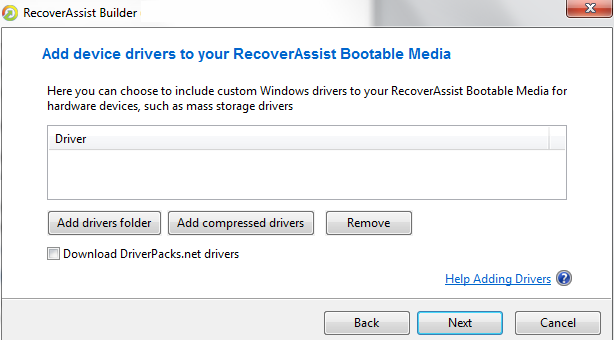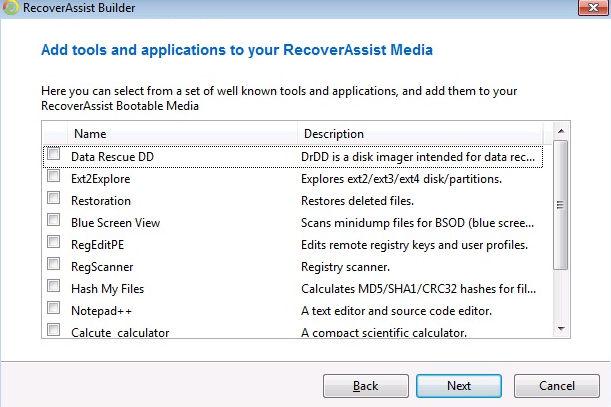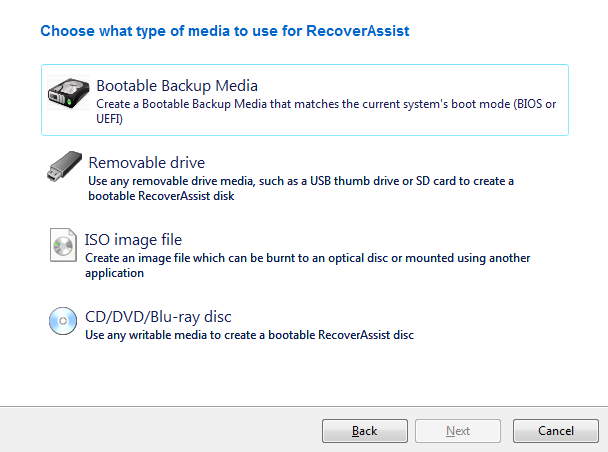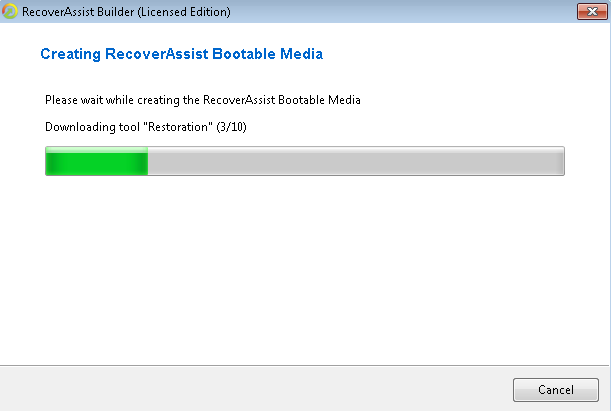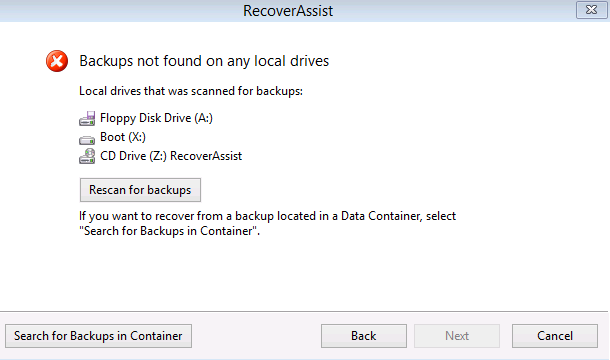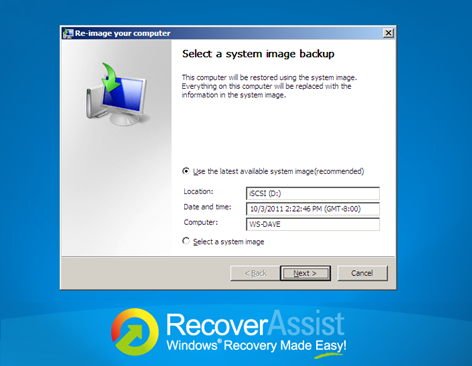 System Recovery
System Recovery
When a hardware or software failure occurs, it is critical that you can recover your system quickly. This guide describes how to create a bootable RecoverAssist media, and how to use that media to launch a RecoverAssist environment and quickly recover a physical server or workstation.
To use RecoverAssist to recover a virtual system, see our Hyper-V guest recovery guide.
Online User Guide
Introduction
Recover your system using a Bootable RecoverAssist Media and an image backup, or a Bootable Backup Media that does not require a separate boot disk. Both solutions will boot your system into a recovery environment, from where you can locate a backup and perform a bare-metal recovery.
Licensing
RecoverAssist is a standard feature included with the BackupAssist license, and requires a BackupAssist license once the initial trial period has expired.
Important: If a RecoverAssist media is created during the trial period, it will expire. The RecoverAssist media will need to be re-created once a BackupAssist license has been purchased. This must be done after you purchase a license, if you want to have a permanent, RecoverAssist bootable media.
Supported recovery media
For a standalone bootable recovery media
- External USB hard drives
- USB thumb drives and SD cards
- CDs, DVDs and BDs
For a Bootable Backup Media
- External USB hard drives
Supported operating systems
The operating system used to make the bootable media must match the operating system in the backup you are using in the recovery. Windows Server 2008R1 and SBS Server 2008 recovery environments must be created from their own installation disks.
Recovery environments can be built from these operating systems:
- Windows Server 2016 - from v9.5 (does not include CSV support)
- Windows Server 2012 / 2012 R2
- Windows Server 2008 / 2008 R2
- Windows Small Business Server (SBS) 2011/2008
- Windows 7, 8, 10
Important: RecoverAssist media cannot be created using a Windows Server Core installation. However, you can use a RecoverAssist media created on a Windows Server installation, to launch a recovery environment and access backups of a Core Server to perform a recovery.
Important: Please review the RecoverAssist reference sheet for a more detailed explanation of the BIOS/EFI, Operating System, backup type and hardware considerations.
RecoverAssist solutions
BackupAssist uses RecoverAssist to create Bootable Backup Media and standalone RecoverAssist Bootable Media. In both cases, the backup must be a System Protection bare-metal image backup.
Bootable Backup Media
A Bootable Backup Media can be used to boot into a RecoverAssist recovery environment and recover the server, without a separate boot disk. If the backup is not a full image backup or the media does not support Bootable Backup Media, a standalone Bootable RecoverAssist Media will be required.
Note: Advanced format (4k sector) drives using BIOS may not work in certain environments. We recommend performing a test recovery to ensure you environment is supported.
Bootable RecoverAssist Media
Standalone bootable media boots into the RecoverAssist environment and uses a bare-metal image backup on separate media, to recover the server. In some cases, Recover tab can also make a backup media into a Bootable Backup Media if System Protection was unable to.
- Created using the Recovery tab.
- Requires a System protection image backup that the recovery environment can access.
RecoverAssist overview
RecoverAssist has two parts. The builder that makes a media bootable and the recovery environment, which is launched by a standalone bootable media or a Bootable Backup Media.
RecoverAssist Builder
The builder creates a standalone bootable media using the Recovery tab. It can also be used by System Protection backup jobs to make backup media bootable. A standalone bootable media can be customized to include files, tools and additional drivers.
The RecoverAssist builder:
- Automatically adjusts the appropriate Windows settings when recovering to dissimilar hardware.
- Avoids many of the Windows Recovery Environment’s Blue Screen of Death issues.
RecoverAssist Recovery Environment
The recovery environment loads from a standalone bootable media or a Bootable Backup Media. It provides a user interface from which you can access your backup and start a recovery.
The Recovery environment:
- Provides access to recovery tools, applications and custom drivers for standalone bootable media, or a Bootable Backup Media that was manually made bootable using RecoverAssist (Recover tab).
- Provides access to a command prompt.
- Can access backups on local or remote destinations.
Creating a bootable recovery media
This section explains how to create a stand-alone bootable media. These steps can also be followed to manually make an backup media bootable, if the System Protection backup job could not.
Launch BackupAssist and follow these steps:
- Select the Recover tab, and you will be presented with two options:
- Create a bootable media using the installed version of Windows – RecoverAssist will use the computer you are on, and its operating system, to create a bootable Recovery disk. If the operating system requires an install disk, this option will be greyed out and not selectable.
- Create a bootable media using a Windows installation disk – RecoverAssist will use a Windows operating system installation disk, to create a bootable Recovery Environment.
- Operating system installation files selection
- If you selected, Create a bootable media using the installed version of Windows, RecoverAssist will confirm the operating system details for the computer you are on.
- If you selected, Create a bootable media using a Windows installation disk, RecoverAssist will try to detect the media. If it cannot, it will ask you to insert the Windows installation disk (for the computer that the recovery media is being created for) and select the drive letter from the drop down list.
- Add device drivers
- Add drivers folder allows you to browse to the location of the drivers that you want to add to the recovery media. Drivers should be added in an unpacked state.
- Add compressed drivers will unpack any compressed drivers you select and add them to the recovery media.
- Download DriverPacks.net will download a recommended driver pack. The drivers will be automatically downloaded and added to the media during the media creation stage.
- Add files/folders
- Add tools and applications
- Select boot media
- Bootable Backup Media
- Removable drive
- An ISO image file
- CD/DVD/Blu-ray disc
- Bootable media creation.
After you make a selection in step 1, RecoverAssist will open a dialog with one of these options:
Note : OEM installations of Windows and Windows installation media provided by system manufacturers may include altered system files that could cause RecoverAssist recovery environments to fail. BackupAssist recommend the use of a Microsoft issued install disk or ISO when building RecoverAssist recovery media.
Select Next
The next RecoverAssist Builder screen allows you to add your own drivers to the bootable recovery media. This is useful to ensure that the recovery environment has the ability to access backup and the local hardware. RecoverAssist will automatically select the appropriate driver to be used during the boot process.
There are 3 selections that can be used to add drivers:
Make your selection/s, and click Next.
The next step allows you to add files and folders to the bootable recovery media. The files and folders will be added to the UserFiles folder in the root directory of your recovery image. You can also add drivers that you do not want to be loaded when the system boots.
Make your selection/s and click Next.
The next step displays a list of troublshooting and support tools to choose from. The applications you select will be added to your recovery media and made available during a recovery.
Make you selection/s and click Next.
This step selects the type of bootable media to be used.
Select the type of media you want to use to create a bootable media. If you want to make a backup media bootable, select Bootable Backup Media. Review the details below to learn more about these options.
RecoverAssist media options:
This option adds RecoverAssist to the backup media. A Bootable Backup Media can be used to boot into a RecoverAssist recovery environment and recover the server, without a separate boot disk. A warning will appear if RecoverAssist needs to format the backup media. If a format is required, all data on the drive, including any backups and backup history, will be lost.
This option will create the recovery image on a removable drive. A warning will advise that the removable drive will be formatted before it is written to. This means everything currently on the drive will be deleted.
This option will create an ISO image. Although the saved ISO image is not on a bootable media, it can be used to create a recovery image that can be saved to a bootable device at a later date.
This option will detect the optical drive on your computer and ask you to select the drive containing the optical media.
The RecoverAssist builder will create a bootable recovery media using the destination selected in step 6.
Applications selected in step 5 will be downloaded from BackupAssist and added to the media.
A progress bar will be displayed. Once it has completed, click finish.
When the builder job has completed, you will be asked if you wish to make an additional RecoverAssist media with the same settings
After the RecoverAssist media has been successfully created, you will have an option to either create an additional RecoverAssist media with same settings or close the RecoverAssist builder.
The RecoverAssist Bootable media has now been created.
Using a bootable recovery media
The recovery process is designed to recover a server or workstation to a previous operating state, in the event of a hardware or system failure
The recovery process will begin by starting your computer using a Bootable RecoverAssist Media or a Bootable Backup Media. The process will load a recovery environment, which you can use to select the location of the backup to be used, and to start the bare-metal recovery.
Recovery requirements
A Bootable RecoverAssist Media
This option requires a Bootable RecoverAssist Media to start the server, and a System Protection bare-metal backup. The backup can be on another media or on an accessible network location.
A Bootable Backup Media
This option requires a Bootable Backup Media. This media contains both RecoverAssist and an System Protection bare-metal backup.
The Recovery process
The following steps explain how to perform a recovery.
- Connect the bootable media.
- Start the computer.
- EFI Systems that have been backed up must be restored by booting RecoverAssist in EFI mode.
- EFI Systems cannot be restored to BIOS systems and BIOS systems cannot be restored to EFI systems.
- EFI booting can be turned off and the system will revert to BIOS mode.
- Make your RecoverAssist selections
- Recover from a backup located on a local drive
- You are using a Bootable Backup Media.
- You are using a Bootable RecoverAssist Media with a separate backup on a local drive.
- Recover from a backup located on a network share
- Recover from a backup located on an iSCSI target
- Repair your installation of Windows
- Launch a command prompt window
- Useful tools and applications
- Clicking on the name of an application will launch that application.
- These tools can be used to perform diagnostics and troubleshoot problems.
- Load driver - loads any additional device drivers that were not included when creating the recovery environment.
- Mount VHD - mounts any VHD such as Windows Backup images. After mounting the VHD, you will be able to access the files using a local drive letter. This option is not used to mount Data containers.
- Support - configure a VNC connection. This connection can be used by BackupAssist technical support to connect to your computer and provide assistance.
- Select an image backup
- If multiple backups are found, you will be given a chance to choose which backup to use.
- If the backup is BitLocker protected, RecoverAssist will prompt for the BitLocker password.
- If your backup is in a Data container, select Search for Backups in Container, and select the Data container. RecoverAssist will display the backups that are in the container.
- Start the recovery
Connect / insert the Bootable RecoverAssist Media or the Bootable Backup Media to the system that is to be recovered.
Your computer should detect the bootable media and begin the boot process. Understanding the boot process can assist if a problem is encountered.
BIOS stage
The system will access its BIOS or EFI and detect the hardware needed to boot. It will display some of the steps onscreen and beep to confirm that it has run successfully. Additional beeps can indicate a problem detecting the required hardware.
O/S stage
Once the system has completed the BIOS stage, it will look for the operating system boot files. The BIOS will be configured with a device order to search for the location of these boot files. The attached bootable media must be configured in this BIOS setting (boot device order) before the C drive. To check or change the boot device order, you will need to access the BIOS configurations by pressing a key during the BIOS stage. The key stroke required may be displayed in screen during the BIOS post process, or noted in your hardware / server documentation.
After the system has started and the BIOS messages have finished, the recovery environment will load. You will see a progress bar or a blank screen followed by an animated Windows logo, depending on the operating system being recovered. When the RecoverAssist environment has loaded, you will be presented with the following screen.
There are 6 options to choose from, and each is described below.
These options can be used to access a backup inside a Data container as detailed in step 4.
Use this option if:
The Recovery Environment will scan the selected media for backup images, and display the backups that were found.
Use this option to provide the location of the backups on network share. The Recovery environment will open a screen that allows you to configure the network card. Network drivers added to the RecoverAssist Builder, are automatically loaded as part of the boot process.
You can modify any TCP/IP network settings or review the automatically assigned settings, before advancing to select the location of the backup. RecoverAssist will search the specified location for backup images and display any images found.
Use this option to provide the location of the backups on an iSCSI target. The Recovery environment will open a screen that allows you to configure the network card. Network drivers added to the RecoverAssist Builder, are automatically loaded as part of the boot process.
You can modify any TCP/IP network settings or review the automatically assigned settings, before advancing to select the location of the backup. RecoverAssist will search the specified location for backup images and display any images found.
This option loads the Windows Recovery Environment and allows you to attempt a repair of the operating system files that caused the system to bluescreen or the Windows load failure. Using the repair function is not necessary for systems that are recovered within the RecoverAssist recovery environment.
This option allows the user to launch a command prompt in order to run the various command line tools included with RecoverAssist.
The tools that can be run include diskpart.exe, bootsect.exe, regedit.exe.
This option will display the applications and tools that you selected to include when you created your RecoverAssist media.
Recovery environment buttons
At the bottom of the Recovery environment UI are three buttons that provide access to additional recovery features.
When you make your selection on the RecoverAssist menu, RecoverAssist will scan the selected location (local drive, network share or iSCSI target) for image backups.
Once you have selected your image backup, click Next and you will be presented with the Re-image your computer screen.
The details of the backup you selected will be displayed.
Click Next, and follow the prompts to start the recovery.

 Belgium
Belgium Canada
Canada Germany
Germany Italy
Italy France
France Spain
Spain United Kingdom
United Kingdom
